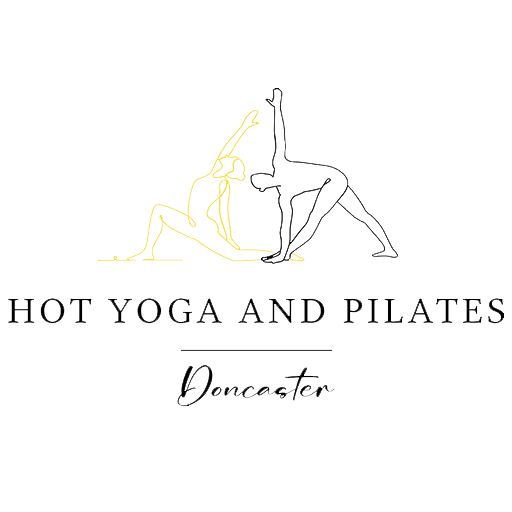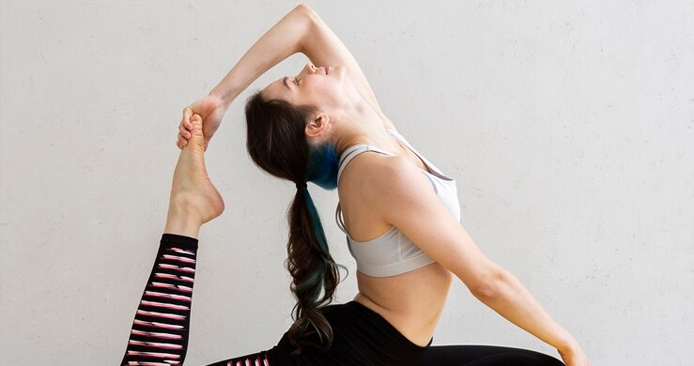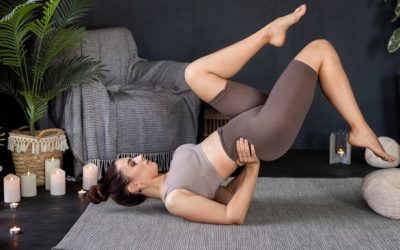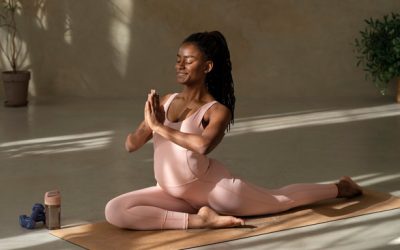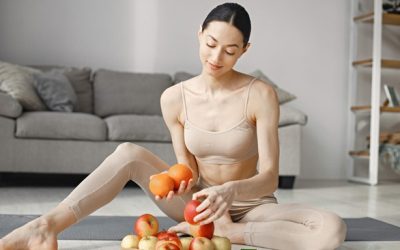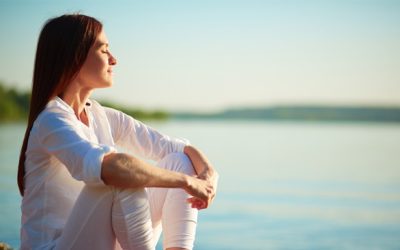oga is the perfect activity for improving flexibility because it is an exercise that follows a series of poses intended to stretch and lengthen muscles and improve overall mobility.
With regular practice, yoga can increase flexibility in all the body’s muscle groups, joints, and ligaments. This improves our range of motion and reduces the risk of injury during surfing or other activities.
Yoga also improves body awareness and hand-eye coordination, which can help us understand our bodies’ limits and abilities. This allows us to work intuitively and safely towards greater flexibility.
This blog will help you think about and understand the various parts of the body and offer the five best poses to increase overall flexibility. You can also simply follow along with Pilar as she leads you through a beginner yoga routine intended to improve overall flexibility: Start Your Yoga Journey: Essential Poses for Flexibility (50 Min.).
What is Flexibility, and Why is it Important?
Flexibility is the ability of a muscle or group of muscles to lengthen or stretch, allowing the joints to move using their full range of motion. Good muscle flexibility and joint mobility are important for overall well-being, as they improve performance in physical activities and prevent injuries. Flexibility can also enhance posture and balance for a variety of activities, including learning to surf.
Improving flexibility throughout the body can help us in various ways:
- Improved range of movement and more mobility overall
- Slows the effects of aging and pain from arthritis or carpal tunnel
- Increases blood circulation
- Reduces muscle tension and pain
- Lowers overall stress levels
- Decreases the risk of injury
- Improves spinal posture
- Reduces back pain
Even an easy cross-legged position (Sukhasana) requires a large degree of hip flexibility and core muscular engagement to be comfortable. This is a position that is often no longer available to those of us who spend hours sitting at a desk, in a car, or on the couch. Other common problem areas are a lack of flexibility in the shoulders, spine, and hamstrings.

How Does Yoga Improve Flexibility?
The muscular system is easily seen within the body. We can see muscles as they move, for example, when we flex the biceps. In yoga we use this attention to the muscular body, specifically the form and function of muscles and how they relate to bones, to invigorate our yoga postures. We focus our attention on the muscles and use the breath to “breathe space” into the muscle tissue, elongating the muscle.
Muscle tissue is made of elongated cells that vary in size and texture according to the muscles’ function. There is a continuous layer of connective tissue called fascia that surrounds the muscles and, in effect, connects us from head to toe. In yoga, as we move, we envision these muscles contracting or releasing according to their natural fibers, in coordination with the breath, and in relationship to the bones- to prevent injury or pain.
What is Fascia, and Why is it Important?
Fascia is connective tissue that surrounds muscles, bones, and organs in the body. It plays an important role in providing support and structure to the body and allowing smooth movement between different systems.
Proper nurturing of fascia is important for maintaining overall health and mobility because fascia helps coordinate movement between muscles and provides a network for transporting nutrients and waste within the body.
When fascia is stressed, it tightens. Other factors that impair fascia are lifestyles with limited physical activity, repetitive movements, or trauma like surgery or injury.
While some poses are known for stretching one muscle group, remember that nothing happens in isolation, and muscles, joints, and fascia all work and stretch together across the entire body with each movement.
Let’s look at some of the key parts of the body that yoga directly targets to improve flexibility.
Yoga Improves Flexibility in These Key Areas
Spine
Yoga improves spinal mobility through three types of poses: backbends, forward folds, and twists, each lengthening and strengthening the entire spinal column and surrounding muscles all the way up to the base of the skull, stretching out and providing natural traction for the cervical spine.
A lack of spinal mobility due to the natural aging process, accident, or misuse, can cause spinal disks to become damaged or “herniated,” exuding out from between the vertebrae, causing immense pain. Find the best routine for spinal flexibility here.

Hands and feet
The joints of the hands and feet directly influence the healthy functioning of the knees, elbows, shoulders, hips, and, ultimately, the entire spine. Using the hands and feet correctly in yoga is often challenging due to years of bad habits.
Foot and ankle flexibility, stability, and alignment are helpful for balance and preventing sprained or twisted ankles. Feet can also hold a lot of tension. Some preparatory exercises before yoga, such as range of motion and joint-releasing exercises for the feet, are particularly good. Joint-releasing exercises for the foot and ankle include these basic movements: dorsiflexion, plantar flexion, rotation, eversion, and inversion.

Hips
In yoga, the hips are the foundation for all other movements in the upper and lower body. There are four groups of muscles that facilitate hip movement, flexibility, strength, and stability.
Those primarily responsible for flexing the hip and drawing the top of the leg toward the torso are commonly called hip flexors. The muscles that extend the thigh from the hip are the gluteus maximus and the hamstrings. Lastly, the inner thigh muscles are responsible for drawing the leg toward the midline of the body.
All these groups of muscles help stabilize and protect the hip joint, interacting with the pelvic floor muscles and affecting core stability.
Hamstrings
Many yoga practitioners, including myself, learn to love and respect their hamstrings, but only after a few years of fearing and cursing them for being so tight. For many beginners, the hamstrings are so tight that forward bends are almost impossible.
All of the hamstring muscles cross the knee joint and attach to the lower leg, meaning tightness in the hamstring can cause pain to radiate from the knee joint. Hamstring tightness can cause lower back pain by pulling the pelvic floor down causing the vertebrae in the lower back to flex forward. Lengthening the hamstrings is key to reducing stress on the lower spine.

Knees
The knee is one of the strongest and most complex joints in the body. Its functionality is directly related to the hip, ankle, and foot joints. The knee connects and facilitates movement between the lower and upper leg and supports all of our body weight. The knee joint connects the tibia, patella (kneecap), and femur through a complicated design of muscles, tendons, ligaments, and bones that fit together for maximum stability and ease of movement.
The two leg bones are separated by a shock-absorbing piece of cartilage (the meniscus) that lies between them. The meniscus can become compromised or injured over time through misuse of the knee joint or injuries that torque the knee.
To “wake up the legs” in standing poses, we are instructed to lift the kneecap, which is partially a function of engaging the quadriceps. This method strengthens and protects the knee joint as well as the four primary ligaments serving to reinforce it.

Shoulder
The shoulder area of the body is complicated, and in common usage, the term shoulder usually refers to the shoulder girdle—the entire part of the upper body that connects the arms to the torso.
It includes three bones: the clavicle (collarbone), scapula (shoulder blade), and humerus (upper arm bone), which are all supported and stabilized by a number of associated muscles, tendons, and ligaments.
The shoulder comprises two joints, but when we talk about the shoulder joint, we’re referring to the glenohumeral. It is a ball-and-socket joint that has more mobility than any other joint in the body and is also more vulnerable to injury due to the shallowness of the fossa and the available range of motion.
Five Asanas — Physical Postures — that Improve Flexibility
The Primary Series of Ashtanga yoga is extremely challenging and is meant for a flexible hip — one most Westerners don’t have due to a lack of squatting. This traditional series declined in popularity due to aggressive alignment adjustments that injured students.
Modern Western yoga students typically practice alternative styles such as Vinyasa, Power, and Flow Yoga, which still use some traditional asanas. These styles are forgiving and fun, encouraging the use of props to accommodate Western bodies and lifestyles. Regardless of what type you start with, it’s important to find a trained teacher who helps you to get safely in and out of the poses.
Modern styles of yoga still include Sun Salutation A and Sun Salutation B, then some of the standing poses like Triangle Pose, Twisted Triangle Pose, Side Angle Pose, Twisted Side Angle Pose, and Extended Forward Bend Pose. The following five yoga poses work flexibility in the entire body, starting with feet and moving up to the hands.

Adho Mukha Svanasana—Downward Facing Dog
A somewhat more strenuous pose at first, after much practice, Downward Dog tones the body so much that it soon serves as a resting pose during an invigorating asana practice. The spine stretching in this pose can help alleviate back pain and improve overall spinal alignment and core strength. Downward Facing Dog is the foundation for all other poses and is a great warm-up to get blood circulating and lubricating the shoulders and hips.
Function: Provides total body lengthening, including the hands, shoulders joints, cervical spine and low back, hamstrings, calves, ankle joints, and bottom of the feet. Stretching the hamstrings in a down-ward dog is gentler on the spine than a standing forward fold, but it still provides valuable traction for the spine, calming the nervous system. Stretching the back of the legs also helps prevent calf and foot cramps while swimming or surfing.
Modifications: Keep a generous bend in the knees or use blocks under your hands to make the pose feel more comfortable for the hamstrings or lower back. To stretch deeper into the pose, try lifting one leg at a time and opening the hip joint, bending the knee so that the knee joint points towards the ceiling. Circling the leg in this position opens up the hip joint and improves hip strength and mobility.
Anjaneyasana—Low Lunge
Function: Low Lunge pose is a hip-opener that focuses on stretching the hip flexors, groin, hamstring, and quadriceps. By lifting the arms, the pose also stretches the chest, shoulders, arms, and neck muscles by lifting and opening the chest and squeezing the shoulder muscles down the back and away from the ears. This pose improves hip and knee mobility while stretching the quads, hamstrings, and groin. Avoid overstretching by keeping the front knee directly over the ankle.
Modifications: Place the hands on blocks to lift the upper body higher off the ground to reduce any tenseness or negative sensations at the start of the pose. Similarly, hands can rest on the knees or hips if tightness in the shoulders is bothersome. If you have knee injuries or sensitivity, place a pillow or folded blanket under your back knee. Tucking the back foot can also reduce tension on the knee joint and stretch the sole of the foot and toes.
Uttanasana—Forward Fold
Function: Standing Forward Fold allows for gentle spine traction, promoting space between the vertebrae and potentially relieving minor back discomfort. The pose encourages a calming effect on the nervous system, helping to reduce stress, anxiety, and fatigue. Hanging with a slight bend in the knee will help gently open the hamstrings as well, but to deepen the stretch, grab onto the big toes with your pointer and middle finger and pull the crown of your head towards your knees.
Modifications: Place a generous bend in the knees to reduce tension on the lower back, or use your hands on your hips to support you. Only fold as far as is comfortable for your lower back, placing your hands on your thighs, shins, or blocks.

Trikonasana—Triangle Pose
Function: Triangle pose stretches and strengthens the core as well as muscles of the legs, hands, back and shoulders. It also stretches and strengthens the thighs, knees, hips, groin, hamstrings, shoulders, chest, spine and ankles. It opens up the hips and stretches the muscles of the spine. Looking at the top hand will also serve to stretch the cervical spine and increase neck mobility.
Modifications: Place a block under the hand instead of the floor or shin to help lift the chest and extend the crown of the head forward. To find ease in the shoulder joints, try placing the top hand on the waist as you twist. To deepen the stretch in the shoulder joint, lower the tricep to the ear, pinky facing down, and stretch the side-body long. If you feel pain in the neck, look toward the bottom hand.

Malasana—Yoga Squat
Function: Malasana improves mobility and stability in the ankles, knees, hips, pelvis, and spine, stretching the lower back muscles as well. It also improves balance by engaging the core and feet. As the heels reach toward the ground, the Achilles tendons and calves begin to stretch. Careful stretching in this pose over time lengthens the hamstrings and the glutes.
Modifications: Widen the feet, place a block under the hips to support you, or keep the heels lifted in the air or on a blanket as you work deeper into the pose. Try to keep as much weight in the feet as possible. Slightly tuck the chin, and remember to keep the spine elongated, with the crown of the head reaching for the sky.

Tips for practicing yoga to increase flexibility
- Set realistic goals and expectations—even a 10-minute yoga practice can help improve flexibility!
- Listen to your body and respect your body’s natural limitations.
- Try to incorporate yoga poses into your regular routine, such as squatting to tie shoes or feed the dog.
- Remember that improving flexibility means both consistency and patience, acknowledging that results are incremental and noticeable sometimes only after months of practice.
- Don’t be afraid to modify poses using props according to your flexibility level—including to help you move deeper into a pose.
- Always push the floor away and lengthen the spine. Lift the kneecaps to protect the knee joint, and pull the belly towards the spine to engage the core. Keeping your muscles engaged will help to protect your joints as you deepen your stretches.
- I also recommend learning how to utilize Ujjayi breath to deepen your poses, or any other Pranayama technique to help you relax the muscles during stretching.
- Remember that yoga improves both physical and mental flexibility if you practice mindfully, incorporating the 8 Limbs of Yoga into your practice.
